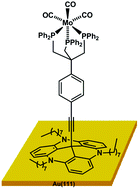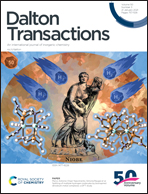Molybdenum tricarbonyl complex functionalised with a molecular triazatriangulene platform on Au(111): surface spectroscopic characterisation†‡
Abstract
Transition metal complexes form the basis for small molecule activation and are relevant for electrocatalysis. To combine both approaches the attachment of homogeneous catalysts to metallic surfaces is of significant interest. Towards this goal a molybdenum tricarbonyl complex supported by a tripodal phosphine ligand was covalently bound to a triazatriangulene (TATA) platform via an acetylene unit and the resulting TATA-functionalised complex was deposited on a Au(111) surface. The corresponding self-assembled monolayer was characterised with scanning tunnelling microscopy (STM), X-ray photoelectron spectroscopy (XPS), and near-edge X-ray absorption fine structure (NEXAFS). The vibrational properties of the surface-adsorbed complexes were investigated with the help of infrared reflection absorption spectroscopy (IRRAS), and the frequency/intensity changes with respect to the bulk spectrum were analysed. A full vibrational analysis was performed with the help of DFT.



 Please wait while we load your content...
Please wait while we load your content...